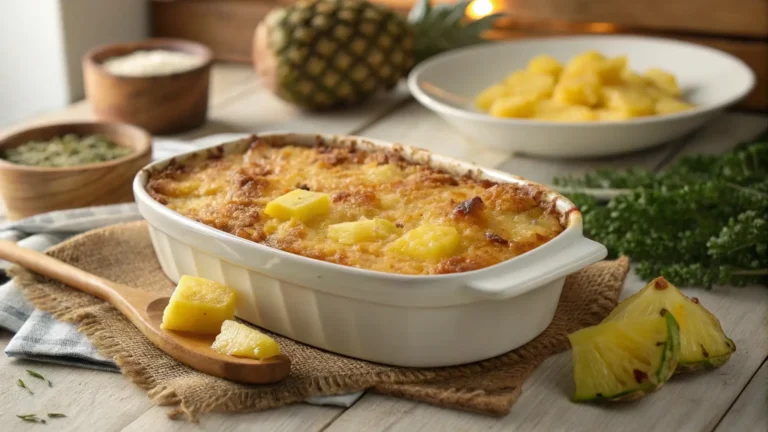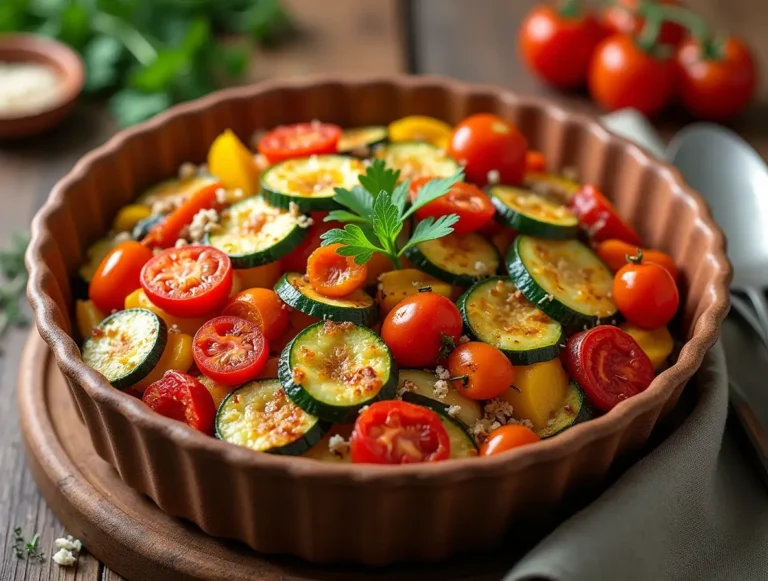How to Make the Best Vegetable Casserole for Dinner
Being a busy parent can make preparing a healthy meal challenging. But, this easy vegetable casserole recipe is here to help. It’s a tasty, family-friendly dish that’s also easy on your wallet. Plus, it’s full of good stuff for your body.
This casserole is a lifesaver on busy weeknights. It’s easy to prepare and sure to be a crowd-pleaser. It’s the perfect solution for a quick, satisfying meal.
Table of Contents
Essential Ingredients for a Perfect Vegetable Casserole
Making a tasty vegetable casserole begins with picking the right ingredients. Whether it’s a garden veggie hotdish, a roasted vegetable medley, or a cheesy casserole, the goal is to mix fresh produce, creamy dairy, and tasty seasonings just right.
Fresh vs. Frozen Vegetables Options
You can choose between fresh or frozen vegetables. Fresh veggies like broccoli, zucchini, bell peppers, and onions bring vibrant colors and crunchy textures. But, frozen mixed vegetables, with green beans, corn, peas, and carrots, are easy on the wallet and just as tasty. If using fresh, blanch them briefly to make them tender-crisp before making the casserole.
Cheese and Dairy Components
Creamy dairy products are key for a great vegetable casserole texture. Cream of mushroom soup, sour cream, and shredded cheddar cheese make a rich, velvety sauce. Try different cheeses like Parmesan or mozzarella for unique tastes.
Seasoning and Spice Combinations
Boosting your casserole’s flavor is all about the right seasonings. A mix of Italian seasoning, garlic powder, onion powder, salt, and pepper can highlight the veggies’ natural sweetness. For more flavor, add paprika, chili powder, or herbs like thyme or oregano.
With these essential ingredients, you’re on your way to a vegetable casserole that will impress everyone.
Kitchen Tools and Equipment Needed
Creating the perfect vegetarian casserole dish requires the right tools. From cutting tools to prep helpers, we’ll cover what you need. These items will help you make a tasty vegetarian casserole.
Cutting and Chopping Tools
- A sharp chef’s knife is key for cutting and slicing veggies. You can find a good one for $19 on Amazon or spend more on a $170 Western-style or $263 Japanese-style knife.
- A serrated knife, like the $18 budget pick on Amazon or the $50 upgrade, is great for cutting through tough bread or veggies.
- A versatile paring knife, like the $15 budget option on Amazon or the $60 upgrade, is perfect for peeling and deveining.
- A sturdy cutting board, from a $12 budget pick on Amazon to a premium $100 set from Williams Sonoma, is essential for safe prep work.
Prep Tools and Accessories
- Mixing bowls, such as the $49 FineDine stainless steel set on Amazon, are crucial for mixing ingredients.
- Accurate measuring cups and spoons, like the $76 All-Clad set on Amazon, help you get precise measurements for great results.
- A flexible spatula or fish spatula, ranging from a $11 budget pick on Amazon to a $65 upgrade, is useful for mixing and transferring ingredients.
- Tongs, such as the $16 budget option on Amazon, make it easy to handle, toss, and serve your casserole.
- A colander, priced around $22 on Amazon, is great for draining and rinsing veggies.
With these tools and equipment, you’re ready to make a delicious vegetarian casserole. It will surely impress your friends and family.
Preparing Your Vegetables for the Casserole
Creating a tasty meatless casserole recipe or a cozy vegetable comfort food starts with how you prepare your veggies. Whether you’re using fresh or frozen, a bit of care can greatly improve your dish’s taste and texture.
Proper Cutting and Chopping Techniques
For fresh veggies, aim for pieces that are all about the same size. This ensures they cook evenly. Cut them into 1-inch chunks. Harder veggies like carrots and potatoes might need a bit more time to soften up.
Blanching and Pre-cooking Tips
Blanching is great for veggies like broccoli and green beans. It keeps them bright and crunchy. Just boil them for 2-3 minutes, then cool them down in ice water. Frozen veggies are usually already blanched, so you can skip this step.
Vegetable Combinations That Work Best
- Green beans, broccoli, and corn
- Peas, carrots, and mixed peppers
- Butternut squash, sweet potato, and brussels sprouts
- Mushrooms, spinach, and cherry tomatoes
These combos offer a mix of tastes and textures. They make your casserole balanced and healthy. Don’t be afraid to try different meatless casserole recipes and vegetable comfort foods to find your favorite.
The secret to a great veggie casserole is in the prep work. It lets the veggies be the stars and work well with the other ingredients. Follow these tips to make a meatless casserole or vegetable comfort food that everyone will enjoy.
Creating the Perfect Creamy Base
Creating a delicious vegetable casserole starts with a creamy base. This part is key as it holds everything together and makes the dish taste better. It’s what makes your nutritious vegetable bakes and plant-based casseroles truly special.
Using cream of mushroom soup and sour cream is a popular choice. But, making your own cream of mushroom soup lets you control the salt and fat. This way, you can make your dish healthier and more flavorful.
Want to avoid sour cream? Yogurt or cottage cheese are great alternatives. Just add a bit of cider vinegar or lemon juice for that tangy taste that goes well with your casserole.
| Ingredient | Quantity |
|---|---|
| Cream of Mushroom Soup (homemade or canned) | 1 can (10 oz) |
| Sour Cream | 1 cup |
| Yogurt or Cottage Cheese | 1 cup |
| Cider Vinegar or Lemon Juice | 1 tablespoon |
The creamy base is the heart of your nutritious vegetable bakes and plant-based casseroles. It adds a smooth texture that holds everything together. By making a few tweaks, you can make it fit your taste and dietary needs perfectly.

Layer-by-Layer Assembly Guide
Building the perfect vegetarian casserole or veggie casserole is all about layering. Start with a solid base of essential ingredients.
Bottom Layer Essentials
Begin by lining the bottom of your casserole dish with frozen vegetables. This adds a nutrient-rich base that soaks up all the flavors. Then, add a layer of cooked rice or quinoa for a hearty texture.
Middle Layer Components
In the middle layers, mix creamy ingredients like cream of mushroom soup and sour cream. This creates a rich sauce that coats the vegetables. Sprinkle shredded cheese for melty pockets of flavor.
Topping and Crust Options
To finish your vegetarian casserole, top it with crushed Ritz crackers mixed with melted butter. Or, try breadcrumbs or crispy fried onions for a gluten-free option. Make sure the topping is evenly spread for a crispy crust.
By layering your ingredients carefully, you’ll get a dish full of flavors and textures. Your family will love your homemade veggie casserole. Enjoy!
Baking Temperature and Timing Tips
Getting the baking temperature and timing right is key for a perfect vegetable casserole or veggie bake. Follow these simple guidelines to make sure your casserole is delicious every time.
Preheat your oven to 350°F (175°C).Place foil over the casserole dish and bake for 30 minutes.This lets the vegetables soften and the flavors blend. Then, remove the foil and bake for another 10 minutes, until it’s bubbly and golden.
To get even browning, rotate the dish halfway through. This prevents hot spots and uneven cooking. Let the casserole cool for 10 minutes before serving. This step helps the flavors meld together.
Your vegetable casserole or veggie bake will bake for about 40 minutes. Watch it closely towards the end to avoid over-browning. With these tips, you’ll have a tasty, perfectly cooked dish to share with loved ones.

| Nutritional Information (per serving) | Value |
|---|---|
| Calories | 296 kcal |
| Carbohydrates | 22 g |
| Protein | 12 g |
| Fat | 18 g |
| Saturated Fat | 5 g |
| Polyunsaturated Fat | 2 g |
| Monounsaturated Fat | 10 g |
| Trans Fat | 0.01 g |
| Cholesterol | 81 mg |
| Sodium | 237 mg |
| Potassium | 485 mg |
| Fiber | 3 g |
| Sugar | 5 g |
| Vitamin A | 972 IU |
| Vitamin C | 88 mg |
| Calcium | 218 mg |
| Iron | 2 mg |
Storage and Make-Ahead Instructions
Storing and preparing your vegetarian gratin or garden veggie hotdish in advance is easy. Just remember a few key tips. This way, your casserole stays fresh and flavorful, making mealtime a breeze.
Refrigeration Guidelines
You can store leftovers in the refrigerator for up to 4 days. Use an airtight container to maintain freshness. When you’re ready, just reheat it in the oven or microwave until it’s hot.
Freezing and Reheating Methods
For longer storage, freeze your casserole for up to 3 months. Allow it to cool, then transfer it to a freezer-safe container or bag. To serve, thaw it in the fridge overnight and reheat until hot.
Want to prep ahead? You can make the base of the casserole and store it separately. Refrigerate it for 1-2 days, then add the topping and bake as instructed. This makes assembling and baking easy on the day you serve it.
| Storage Method | Maximum Duration |
|---|---|
| Refrigerator | 4 days |
| Freezer | 3 months |
By following these simple tips, you can enjoy your delicious vegetarian gratin or garden veggie hotdish anytime. You won’t lose any flavor or convenience.
Serving Suggestions and Pairings
The roasted vegetable medley casserole is a hit with its savory aroma and comforting flavors. It’s perfect as a meatless main course or a tasty side dish. It’s great for Thanksgiving or a healthy dinner any night of the week.
Pair it with a simple green salad and some crusty bread for a nice contrast. The fresh greens and crunchy bread will balance out the creamy casserole. Grilled chicken or salmon fillet add a protein-packed twist to the meal.
Adding chopped parsley on top adds color and freshness. It’s a simple touch that makes the dish look and taste better.
This casserole is versatile and fits many meals and occasions. Enjoy it as a main dish for a cozy dinner or as a side for Thanksgiving. It’s a healthy dish that everyone will love.
| Pairing Suggestions | Serving Ideas |
|---|---|
|
|
“The roasted vegetable medley casserole is a true crowd-pleaser, with its vibrant colors and comforting flavors. It’s a versatile dish that can be enjoyed year-round, whether as a meatless main or a delightful side.”
Conclusion
Vegetable casseroles are tasty, healthy, and can be made your way. They’re great for using up veggies, fitting different diets, and making meals cozy. This recipe is a starting point for making your own meatless casserole recipes and vegetable comfort foods.
Looking to eat more plants or just want a cozy meal? Vegetable casseroles are a tasty and flexible option. By learning the basics and trying new ingredients, you can make a casserole that’s both delicious and good for you.
So, get creative with casseroles and find new ways to make veggie dishes. Turn fresh or frozen veggies into big, tasty meals that everyone will love. Enjoy making and eating these meatless casserole recipes and vegetable comfort foods that make your meals warm and satisfying.
Top Reviews and Expert Insights on Casserole Recipes
There are no reviews yet. Be the first one to write one.







